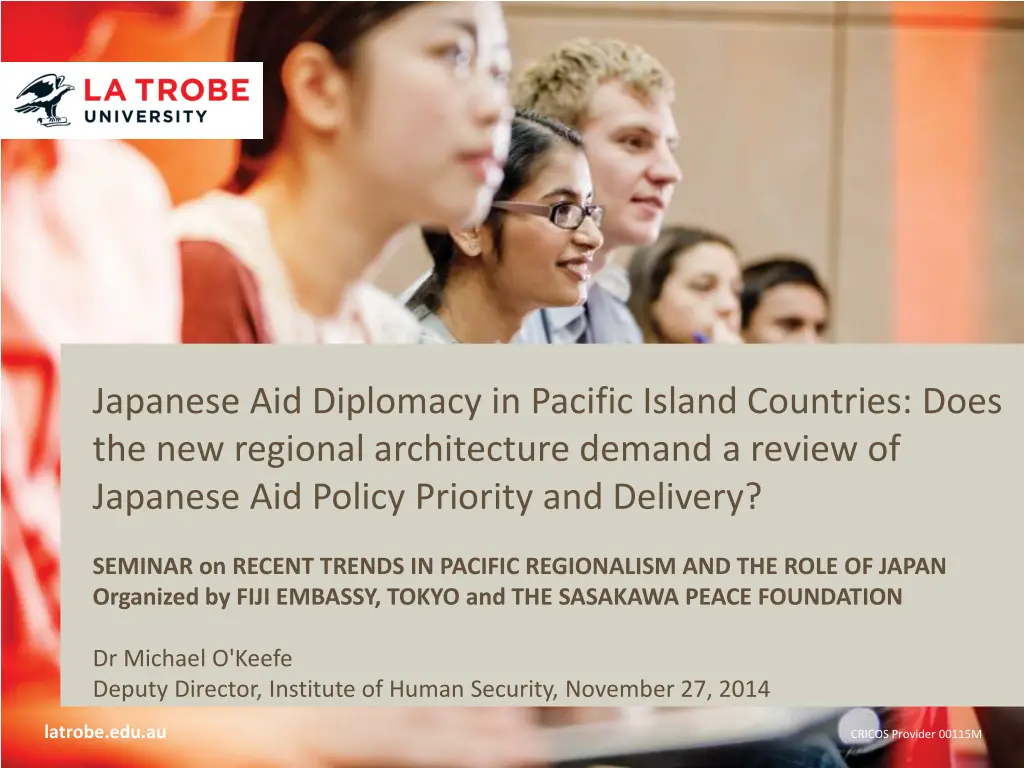
Japanese Aid Diplomacy in Pacific Island Countries: Reviewing Policy Priorities
Explore the evolving landscape of Japanese aid diplomacy in Pacific Island countries through discussions on regional architecture, aid paradigms, and geopolitical shifts, urging a reevaluation of aid policy priorities. Delve into the challenges facing the Pacific region and the role of Japan in navigating these changes.
Download Presentation

Please find below an Image/Link to download the presentation.
The content on the website is provided AS IS for your information and personal use only. It may not be sold, licensed, or shared on other websites without obtaining consent from the author. If you encounter any issues during the download, it is possible that the publisher has removed the file from their server.
You are allowed to download the files provided on this website for personal or commercial use, subject to the condition that they are used lawfully. All files are the property of their respective owners.
The content on the website is provided AS IS for your information and personal use only. It may not be sold, licensed, or shared on other websites without obtaining consent from the author.
E N D
Presentation Transcript
Japanese Aid Diplomacy in Pacific Island Countries: Does the new regional architecture demand a review of Japanese Aid Policy Priority and Delivery? SEMINAR on RECENT TRENDS IN PACIFIC REGIONALISM AND THE ROLE OF JAPAN Organized by FIJI EMBASSY, TOKYO and THE SASAKAWA PEACE FOUNDATION Dr Michael O'Keefe Deputy Director, Institute of Human Security, November 27, 2014 latrobe.edu.au CRICOS Provider 00115M
Overview The Policy Problem Why Now? Regionalism and Geopolitics Has the Aid Paradigm Shifted? Influence Aid and Bilateral Delivery Old Friends, New Friends Successful/Distinctive Strategies La Trobe University La Trobe University 2 2
The Policy Problem Regional Architecture under Challenge from: Capacity Constraints (Successive Critical Reviews) Alternative forms of Regionalism (PSIDS, PIDF) New Players (China, Russia, Middle Eastern Countries etc) New Aid Paradigms (Rise of Influence Aid ) Implications: Pacific Region at a Crossroads Influence of Old Friends in Relative Decline La Trobe University La Trobe University 3 3
Why Now? Regionalism and Geopolitics Critical Reviews of PIF, SPC & Pacific Plan Declining legitimacy? Declining relevance to Pacific Interests? Fiji and PIDF A Regional Demand for Alternatives La Trobe University La Trobe University 4 4
Has the Aid Paradigm in the Pacific Changed? 1. The Global Shift to Middle Income countries Not reflected in the Pacific 2. The Global Shift away from Infrastructure Not Necessarily in Pacific 3. Global Aid Policies Increasingly Driven by Donor National Interests ( influence aid ) Yes in the Pacific La Trobe University La Trobe University 5 5
1. The Global Shift to Middle Income countries Not in the Pacific Most poverty is now in Middle Income countries (e.g. India or Indonesia) Global Shift in Aid Underway to Adapt but implications unclear for the Pacific Poverty Alleviation still No. 1 Goal in Pacific A Gulf Between Two Aid Worlds opening Opportunity for Japan to Respond to Pacific needs (e.g. refocus PALM) La Trobe University La Trobe University 6 6
2. The Global Shift away from Infrastructure Not Necessarily in Pacific Developed Countries Now Providing Services to Middle Income Countries (capacity building, etc) But Non-Western Countries (e.g. China and Russia) flexible Infrastructure, cash, untied loans Opportunity for Japan to Focus on Specialised Projects and Services (e.g. solar, medical) La Trobe University La Trobe University 7 7
3. Aid Policies Driven by Donor National Interests ( influence aid ) Yes in the Pacific Best Practice Aid (good governance, sustainable development etc) under pressure Aid for Trade Aid focused on Strategic Interests (especially non-Western Countries) Ability to Maximise Use of Donor Resources (e.g. Chinese concrete and workers) Opportunity for Japan to strengthen focus on Needs of Recipients La Trobe University La Trobe University 8 8
Influence Aid and Bilateral Delivery Old Friends, New Friends 1980s-90s Japan No. 2 Donor 2000s - Rise of China in the Pacific 2014 - A Crowded field China, Russia, Middle Eastern Countries Relative Decline in Japanese Aid. A Targeted Approach Needed to maintain impact and Influence La Trobe University La Trobe University 9 9
Successful/Distinctive Strategies Triangular Cooperation (with Fiji to Reach Smaller PICS) Aid Coordination with Similar Aid Donors (Australia NZ, US) Deep bilateralism (PALM & Track II) to Align Focus with Regional Interests Market Access (Products and Labour) La Trobe University La Trobe University 10 10
Focus on Triangular Cooperation Niche projects tailored to Pacific interests Foreign Direct Investment (FDI) Market access for Pacific Products Labour Mobility CSO/NGO Collaboration La Trobe University La Trobe University 11 11
Thank you latrobe.edu.au CRICOS Provider 00115M
